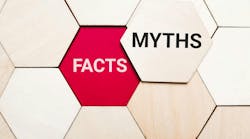Many new, commercial refrigeration technologies provide solutions to contractors and their customers for issues related to high energy costs and refrigerant charges. While it's generally assumed that improvements in these areas increase equipment costs, this isn't always true. Any additional costs for new, efficient technology over "standard efficiency" technology are offset by utility incentives, governmental tax credits, and ongoing savings in electrical use. A holistic review of the overall cost of ownership for efficient products may pleasantly surprise a customer. Refrigeration system compressor energy consumption is dependant on system design and operation variables, such as discharge pressure, suction pressure, refrigerant mass flow rate, and refrigerant density in the suction line. Efficiency innovations for commercial applications optimize these variables.
Retrofit and replacement projects at grocery stores can reduce overall system energy consumption through use of the following technologies:
- liquid desiccant air conditioning (LDAC)
- hybrid air cooled condensers
- integral variable speed condenser fan motors
- refrigerated cases with improved discharge air flow
- electronic control systems
- LED shelf lights
- electronic expansion valves
- digital compressor capacity controls.
Additionally, utility incentives and tax credits exist for many of these technologies. For more information on utility incentives in your area, visit www.dsireusa.org.
Proper Integration Reduces Other Costs
While incentives, credits, and reductions in energy use offset any cost premiums for the above technologies, their proper integration can reduce other equipment and installation costs. For example, LDAC technology is used to dehumidify the recirculated and make-up air in a grocery store. This technology lowers the compressor horsepower requirements for the air conditioning and refrigeration systems. Hybrid air-cooled condensers, improved air-flow cases, LED shelf lights, and electronic expansion valves allow for smaller refrigeration compressors. Smaller compressors cost less and require smaller electrical wiring, contactors, circuit breakers and refrigeration lines. These products also allow for smaller, less expensive refrigerant charges in air conditioning and refrigeration systems. Refrigerant charge can be reduced even more by using new microchannel, air-cooled condenser technology.
Longer Life, Fewer Leaks
Maintenance costs are typically lowered through longer equipment life of compressors and lighting,and reduced refrigerant leaks. Reduced operating compression ratios (lower discharge pressures/higher suction pressures), optimized superheat, precise electronic compressor capacity modulation, and reduced compressor cycling, all improve compressor life.
LED lights last longer and thus reduce replacement costs. Electronic control systems eliminates the need for electro-mechanical pressure controls with leak prone flare fittings, capillary tubes and bellows.
Overall, the total costs of ownership for energy efficient technologies tend to be lower than "standard efficiency" technologies upfront and for the long-term. In addition, reductions in energy use and refrigerant leakage lower a customer's environmental impact and related carbon footprint. This, in turn, strengthens the customer's green, sustainable image.
Scott Moore is a senior engineer for the EnergySmart Grocer program designed by PECI, an energy efficiency consulting agency. He can be reached at [email protected]. PECI designs and implements energy efficiency programs and research for utility companies and governmental agencies.








